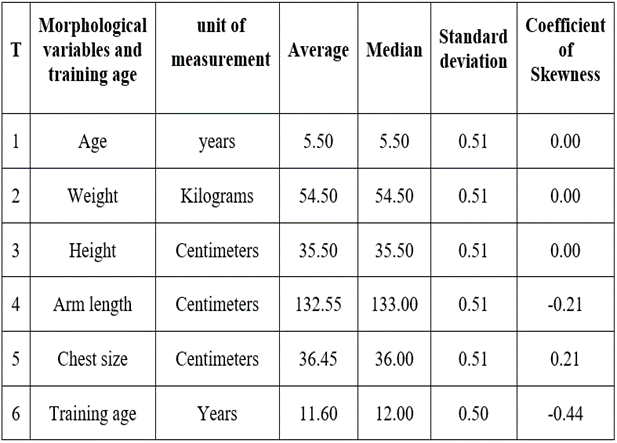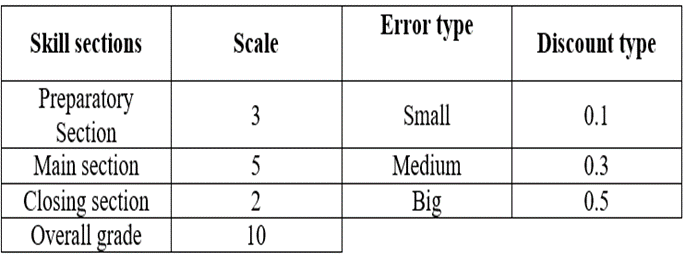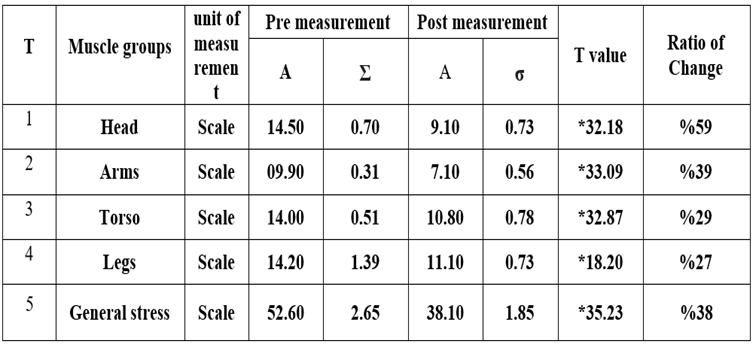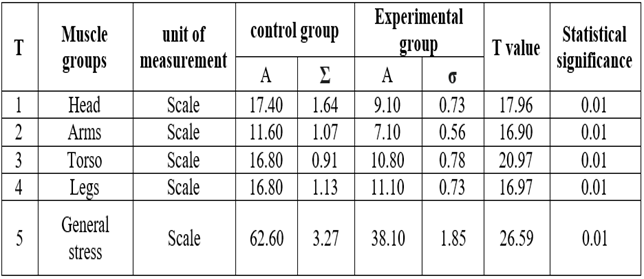Review Article | DOI: https://doi.org/10.31579/2835-7957/013
The Impact of a Training Program for Cascade Relaxation on the Performance of the Individual Back-Air Cycle Junior Gymnasts (10-11 Years Old)
1 University Khmis Maliana, Algeria.
2 University Alger, Algeria.
3 University Professor, University of Mostaganem, Algeria.
*Corresponding Author: Gorine Ahmed, University Khmis Maliana, Algeria.
Citation: Ahmed G., Mohammed M., Ibrahim H., (2023). The Impact of a Training Program for Cascade Relaxation on the Performance of the Individual Back-Air Cycle Junior Gymnasts (10-11 Years Old), Clinical Reviews and Case Reports, 2(1); DOI:10.31579/2835-7957/013
Copyright: © 2023, Gorine Ahmed. This is an open-access article distributed under the terms of the Creative Commons Attribution License, which permits unrestricted use, distribution, and reproduction in any medium, provided the original author and source are credited.
Received: 06 February 2023 | Accepted: 20 February 2023 | Published: 28 February 2023
Keywords: cascade relaxation; skill performance; back somersault straight; artistic gymnastics
Abstract
This study presents one of the modern techniques in the field of cognitive psychology and completes the training process for artistic gymnastics coaches, in order to develop the performance level of artistic gymnastics juniors. The study included two homogeneous and equal groups, one experimental and the other controlled. The two researchers applied the training program for cascade relaxation accompanying the skill training to the experimental sample consisting of 8 young gymnasts to know the impact of this type of training in developing the skill level of the individual back somersault, while the control group underwent skills training only, and the duration of the program was limited to 8 weeks at 3 training units per week, the duration of each unit is 15 minutes.
Findings showed that there is a positive direct correlation between the development of the relaxation ability level and the skill level of the back somersault straight for young gymnasts.
Introduction
The nature of high athletic levels requires the athlete to use his physical, skill, planning, psychological and mental abilities in an integrated manner in order to try to achieve the best possible performance. The methods of physical, skill and plan preparation and its principles have converged to a great extent during recent years, and therefore the need for more attention to the mental aspect has emerged. (Abdel-Al 2013, 58)
Gymnastics for men is one of the competitive sports activities that are important in the competitive field at the global and Olympic level, in which players compete for six devices, where the nature of performance on each device varies according to the nature of the geometrical structure of this device.
Ground movements are the mainstay of all gymnastics movements, and the performance on the floor mat device is linked to certain motor paths that depend on the link between the mind and the motor performance, this requires the player to focus in order to perform skill in a dynamic manner, so the physical and skill preparation is not sufficient for excellence and achievement.
In order for a player to achieve optimal performance, he or she must be accompanied by training in fitness elements, motor skills and mental skills such as relaxation so that they can be used to develop the mental abilities of the athlete in order to help him to think properly and make appropriate decisions.
Mental pressures are the most influential on performance. Negative thinking and confusing ideas such as fear of failure and fear of injury that enter the mind, this results in increased physiological and physical arousal and reduced ability to make the right decisions, which are factors that negatively affect performance. (Shimon and Majda 2002, 191-200)
Relaxation is an important psychological or mental skill in the possibility of developing performance and preparing the player before training or competition, so it should be taken care of along with physical, skill and plan aspects. It is important to reduce anxiety levels and contribute to delayed onset of muscle or mental fatigue and speed of recovery from physical and mental exertion. The ability to adjust the level of emotional stimulation also has positive effects on physical and skill aspects, especially in gymnastics, which requires a high degree of compatibility, accuracy and concentration. (Akla 2010, 188)
Based on the above, the two researchers in this study tried to highlight the positive impact that a training program for cascade relaxation can play on the development of the performance of the skill of the back somersault straight for young artistic gymnastics (11-12) years old.
General wonder of the study:
Does the proposed cascade Relaxation training program have a positive impact on the development of back somersault straight performance among art gymnasts’ juniors?
Methodology of research
Research Methodology: The researcher used the experimental method because of its suitability to the nature of the research and its objectives.
Experimental design: The researcher relied on the experimental design with two experimental and control groups with pre and post measurement for each.
Research community: The research community is represented in (50) young art gymnasts (10-11) years old and registered in the State Gymnastics Association in the wilaya of Saida/Algeria for the sports season 2021/2022.
The core study sample: (20) artistic gymnasts (10-11) years old were deliberately chosen from the Nassr Gymnastics Club from the wilaya of Saida/Algeria, where they were randomly divided into two homogeneous and equal groups and (10) young people for each group.
Determination of search variables:
Independent Variable: Proposed cascade Relaxation training Program.
Dependent variable: The level of performance of the ground movements under study.
Extraneous variables: The researcher tried to isolate or control them so that the change in the dependent variable can be attributed to the effect of the experimental variable (independent) by conducting homogeneity between the two research samples in the following variables: (Morphological measurements/skill tests/relaxation ability test) In addition, the two groups are exposed to the same experimental conditions ( they train at the same time and the same gym and undergo standardized physical and skill training in terms of size, intensity and density).
Statistical description of the research sample in the study variables:

It is clear from Table 1 that the torsion coefficients are limited between (+3) and (-3) in the variables (age – length – weight – arm length – chest size – training age), which indicates homogeneity among the members of the core study sample.

It is clear from Table 2 that the torsion coefficients are limited between (+3) and (-3), which indicates homogeneity among the individuals of the core study sample in the level of skill performance.

It is clear from Table 3 that the torsion coefficients are limited between (+3) and (-3), which indicates homogeneity among the members of the core study sample in the levels of muscle tension.
Research tools and means of data collection:
Nideffer Muscle Tension Levels Card (1985):
- Its Arabic version was prepared by Muhammad al-ArabiShamoun and Majda Ismail.
This card aims to identify muscle tension levels in four muscle groups (facial, neck, and jaw muscles – shoulder, chest, and arms muscles – abdominal and back muscles – thigh and leg muscles) as a way to identify the optimal level of excitement. - It consists of three levels of muscle tension (total relaxation – moderate tension – high tension).
Skill level evaluation form: A form was prepared to assess the performance level of the posterior straight air cycle skill, then it was presented to 4 experts in international gymnastics arbitration and its final version is shown in Table 1.

Proposed Cascade Relaxation Training Program:
Duration of the program
The application period of the program was set at 8 weeks and at 3 units per week, the duration of each training unit is 15 minutes, thus the total number of training units is 24 units, and the hourly volume is 6 hours, i.e., 360 minutes
Objectives of the proposed training program:
- Work to reduce levels of anxiety and muscle tension.
- Good control of the muscular system.
- Help control some physiological responses.
- Ability to adjust the level of emotional excitation.
- Help reach high levels of calm and psychological comfort.
- Isolate non-performance stimuli and reach the highest levels of attention.
- Develop performance of the individual back somersault.
Interpretation and discussion of findings:
Interpretation and discussion of the results of the first hypothesis:
Hypothesis text: There are statistically significant differences at the significance level (α ≤ 0.05) between the pre and post measurements of the experimental group in the level of relaxation ability and the level of performance of the back somersault straight
Interpret and discuss findings related to muscle relaxation:
Table 2 test T to indicate the differences between the pre and post measurement of the experimental group in the levels of muscle tension (ability to relax).

(n=10) It is clear from Table 2 that there are statistically significant differences at the level of significance (α≤ 0.05) between the pre and post measurements of the experimental group and in favor of post measurement in all dimensions of muscle relaxation, which are muscle tension (head, arms, torso, legs).
The researcher attributes these differences to the impact of relaxation exercises that addressed areas where tension is concentrated, such as (neck – face – shoulders – arms – abdomen – back – legs), which had a significant impact in reducing tension and achieving relaxation for all areas of the body.
This is what Shimon (2001) noted: Relaxation exercises help reduce the impact of stress response and help optimize stress, increase concentration, eliminate anxiety, and develop and activate the forces of mental perception, as well as increasing the ability to work for long periods in addition to the many physical and psychological benefits that can be achieved with the development of the ability to relax. (Shimon 2001).
This is consistent with the view of Sulaiman and Thamer Mahmoud (2010) that cascade relaxation exercises have several psychological benefits such as (emptying repressed emotions, maintaining emotional stability, eliminating negative thoughts, and reducing levels of anxiety and muscular and mental tension). And other physiological benefits such as (reducing the effect of the sympathetic nervous system responsible for increasing the state of emotion and anxiety, releasing adrenaline hormone, and helping to produce beta endorphin (beta endorphin), which relieves pain and is a source of reassurance and pleasure. (Akla 2010)
Discussing the results related to the level of performance of the posterior straight air circulation:

(n=10) The results of Table 3 indicate that there are statistical function differences at the level of significance (α≤0.05) between the pre and post measurements of the experimental group and in favor of post measurements in the level of performance of the back somersault straight
The researcher attributes these differences to the proposed program based on the relaxation trainings accompanying the skill trainings, this is what Abeer and others (2019) pointed out that training psychological skills such as relaxation helps to reduce stress and anxiety and to acquire the skill of controlling the muscular system to reach the degree of optimal relaxation that helps to increase performance during the training process. Mental skills development exercises also have a positive impact on reducing psychological stress and maintaining the optimal level of emotional stimulation that leads to flow in skill performance and helps reduce errors, this leads to self-control of negative ideas affecting performance and turning them into positive ideas that lead to the best sports achievements. (Abeer 2019)
Thus, it can be said that the first hypothesis, which states that there are
statistically significant differences at the significance level (α≤ 0.05) between the pre and post measurements of the experimental group in the level of the ability to relax and the level of performance of the skill of the back somersault straight has been achieved.
Interpretation and discussion of the results of the second hypothesis:
Hypothesis text: There are statistically significant differences at the significance level (α ≤ 0.05) in the downstream measurements between the experimental and control groups in the level of relaxation ability and the level of performance of back somersault straight and in favor of the experimental group.
1.3.1- Discussing results related to cascade relaxation:
Table 4 shows the T test to indicate the differences in post measurements between the experimental group and the control group in muscle tension levels (ability to relax).

It is clear from Table 4 that there are statistically significant differences at the significance level (α≤ 0.05) in the post measurements between the experimental and control groups and in favor of the experimental group in the muscle tension levels of the muscle groups (head, arms, torso, legs).
The researcher attributes the reason for these differences to the exercises of cascade relaxation, which have had a great impact in reducing tension and achieving relaxation for all areas of the body and a sense of clarity of mind in the experimental group.
This is what Rateb (1995) pointed out that the skill of relaxation makes the individual ready for the pressures that come to him as a result of internal or external factors that enable him to mobilize his physical, mental and emotional energies and allow him to reduce anxiety, tension and excessive excitement to the appropriate level. (Osama 1995).
This is consistent with the study of Ayman Najmuddin Abbas et al. (2018) that relaxation exercises contribute to the hormonal regulation of both hormones (triiodothyronine T3, thyroxine T4, ACTH, cortisol, serotonin, and TSH ) Increasing it to meet the requirements of completion immediately before the start of the competition, as well as contributing to the regulation of blood sugar and reducing it before the competition, as well as reducing the time for completion, especially in events that require high speed. Iman Najm Al-Din Abbas.
1.3.2- Discuss the results related to the level of performance of the straight rear air circulation skill:
Table 5 shows the T test to indicate the differences in measurements between the experimental group and the control group in the level of skill performance of the ground movements under study.

From Table (05), it is clear that there are statistically significant differences at the significance level (α≤ 0.05) in the measurements between the experimental and control groups and in favor of the experimental group in the performance level of the back somersault straight.
The researchers attribute these differences to the effectiveness of the skillful relaxation exercises, which helped the players reduce the level of physical and cognitive anxiety, adjust the level of emotional arousal, and strengthen self-confidence. This has helped to quickly learn and gain the skill of back somersault straight.
Hassan Allawi (2002) pointed out that the ability to relax muscles plays an important role in the speed of performance, as it is known that muscle tension, especially for anti-muscles, is one of the factors that hinder the speed of motor performance and the slowness and lack of mastery of the player for the correct way of performing the movement and to the high degree of excitement and emotional tension. (Alawi 2002, 100)
This is consistent with the study of Suleiman Akla, Thamer Mahmoud (2010) that relaxation exercises are highly effective in reducing the anxiety levels of players, controlling their emotions before, during, or after training and competition, and contributing to delaying the emergence of muscle or mental fatigue and the speed of recovery from physical and mental effort. The ability to adjust the level of emotional stimulation also has a positive impact on motor skills, especially those that require some kind of compatibility, accuracy and concentration, as well as contributing to reducing tired physical repetitions and saving time and effort. (Akla 2010, 199)
Thus, it can be said that the second hypothesis, which states that there are statistically significant differences at the level of significance (α ≤ 0.05) in the measurements between the experimental and control groups and in favor of the experimental group in the level of performance of the back somersault straight has been achieved. (Abeer 2019)
General conclusions
In light of the objectives of the research and the assumptions and conclusion of what resulted from the statistical treatment, it was possible to reach the following conclusions:
The proposed training program for cascade relaxation has actively and positively contributed to:
- Reduce muscle tension levels in the experimental group.
- Good control of the muscular system.
- Isolate non-performance stimuli and reach the highest concentration of attention.
- Developing the performance level of the individual back somersault
Based on the results of the research, the following suggestions can be made:
- The need to combine relaxation training with skills training in order to achieve the best results physically and skillfully.
- Raising the awareness of those in charge of the training process and preparing athletes on the importance of mental skills (relaxation) and their effective role in the rapid acquisition and mastery of motor skills.
References
- Abdel-Al, Ali. (2013). The impact of mental training on some psychological skills and the level of skill performance in ballet. Assiut Journal of Physical Education Sciences and Arts.
View at Publisher | View at Google Scholar - Abeer, Adel. (2019). The impact of a training program for some mental skills on learning to shoot from stability in basketball for female students in basic education. Journal of the Faculty of Physical Education, 197-213.
View at Publisher | View at Google Scholar - Akla, Thamer. (2010). The Impact of the Cascade Relaxation Program on Examination Anxiety and Practical Achievement in Gymnastics among Students of the Department of Physical Education of the University of Mosul. Rafidain Journal of Mathematical Sciences.
View at Publisher | View at Google Scholar - Alawi, Mohammed Hassan. (2002). Psychology training and sports competition. Cairo: Dar al-Fikr al-Arabi.
View at Publisher | View at Google Scholar - osama, kamel rateb. (1995). The Psychology of Competition. Cairo: Dar al-Fikr al-Arabi.
View at Publisher | View at Google Scholar - Shimon, Mohammed Al-Arabi. (2001). Mental training in the field of sports. 2. Cairo: Dar al-Fikr al-Arabi.
View at Publisher | View at Google Scholar - Shimon, Mohammed Al-Arabi, and Ismail Majda. (2002). Psychological Guidance and Counselling in Sports. Cairo: The Book Center for Publishing.
View at Publisher | View at Google Scholar

 Clinic
Clinic
